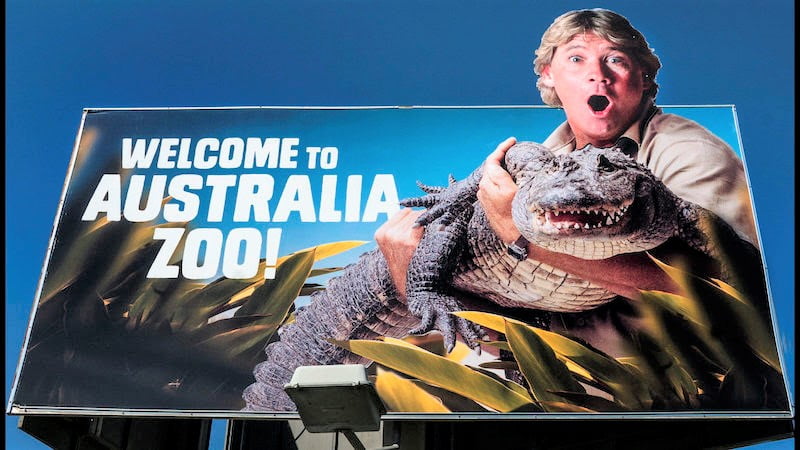
By Justine E. Hausheer
Contributing Writer
All conservationists have an origin story. A moment, a place, or an experience in our lives that laid down biophilia into our bones.
For me, it was Steve Irwin.
Crikey, She’s a beaut!
From ages 11 to 12, I was obsessed with Steve Irwin. I waited for the weekly episodes of The Crocodile Hunter with a religious zeal that (to my mother’s dismay) Sunday mass could never replicate.
I spent hours playing on the lakeshore in our backyard — dressed in khaki shorts and a wide-brimmed hat — using a net to catch minnows and tiny bass, crayfish and red-eared sliders. I’d narrate my exploits in an abysmal Aussie accent, pretending to star in my own television show for an audience of one. Irwin mania gripped America just as I was entering the sixth grade when the relatively innocent social hierarchies governing elementary school transitioned to the full-blown politics of early adolescence. As you might have already guessed, I was not a cool kid.
I’d always been a quiet nerd. My parents discovered that the most effective way to guarantee good behavior was to threaten to take my books away. As I entered my early teenage years, I remained firmly in the oddball group.
My clothes weren’t stylish enough, my mother wouldn’t let me wear makeup yet and I wasn’t willing to curry favor by letting the boys win at playground games of tag. The usual adolescent identity crisis ensued, aided by Mean-Girls-level bullying and gaslighting from the popular girls.
But I had the outdoors. Away from school I could play as I liked, following raccoon prints across the sandy lakeshore and learning how to catch garter snakes with my mother. And I had Steve Irwin, who loved wildlife with an unabashed enthusiasm that a paralytically self-conscious tween girl could never muster. Irwin didn’t care if a snake peed on him or if he got dirty. He said weird things like “Crikey!” and didn’t care what other people thought of him.
If he could do it, then I could do it, too.
So I became the crocodile girl. I abandoned my dreams of being a veterinarian and decided to become a herpetologist instead. (This declaration was usually met with blank stares by adults and adolescents alike.) I had a crocodile birthday party with a dorky leather hat, and I even signed my name with a little crocodile stick hieroglyph of my own design.
While my love of crocodilians certainly didn’t make me cool, Irwin’s popularity gave me a shield. I was always going to be weird, but at least I wasn’t the only one.
My crocodile days faded with time. I changed schools, got a bit less awkward and found a new identity in athletics and my love of language and literature. The crocodile girl became the volleyball player and wannabe poet, who later became a rower and lover of southern American literature. I forgot all about Steve Irwin until I saw his obituary on the news during my first week of college. And then I promptly forgot about him again until I started working in conservation.
Years after his death, Irwin’s reputation in conservation circles is mixed. Most criticisms of Irwin arise from his handling of wildlife with detractors arguing that he unnecessarily harassed wild animals to benefit his own celebrity. Another often-mentioned incident occurred when Irwin walked through a captive crocodile enclosure with a dead chicken in one hand and his 1-month-old son in the other.
Despite the cowboy persona, Irwin was a serious conservationist. He helped found a research project with scientists at the University of Queensland, who still use his croc-capture techniques more than a decade later to tag and release dozens of saltwater crocodiles. The satellite-tracking data they gather are helping scientists better understand a creature that — for obvious reasons — would otherwise remain enigmatic.
Irwin taught millions of children like me that wildlife — even the ugly, slimy and scaly — should be loved. Before him, popular culture dictated that snakes and spiders and the other uncharismatic critters should be feared and eradicated. He taught me to love alligators and myself. And he inspired and encouraged an entire generation of budding naturalists, scientists and conservationists.
Did Irwin unnecessarily manhandle animals in the process? Probably. Is the Australia Zoo enterprise a bit too commercialized with a patina of camera-ready schtick? Absolutely. I can live with both of those things.
I finally visited Irwin’s Australia Zoo about a year ago, with my partner’s 6-year-old niece and 8-year-old nephew in tow. We watched saltwater crocs lolling lazily in the Australian winter sun, ogled a cassowary scarfing down mangoes, and played “Where is the snake hiding?” in the reptile enclosure. I loved it. And I saw a ghost of my young self as I watched the kids run from one exhibit to another.
Some conservationists may raise an eyebrow at the mention of his name, but I will be forever grateful to Steve Irwin for encouraging an insecure little girl to embrace nature with enthusiasm, curiosity and compassion.



